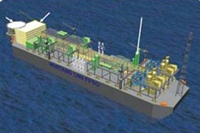ExxonMobil, BHP to develop world's largest floating LNG plant
02 Apr 2013
ExxonMobil and BHP Billiton will develop a huge natural gas field off the coast of Australia, that will use the world's largest floating platform to process liquified natural gas (LNG) at sea.
 The platform would draw gas from the remote Scarborough gasfield, located in the Carnarvon Basin around 300 km from the coast of West Australia that the two oil giants are developing, and process ir for exports on the floating LNG terminal.
The platform would draw gas from the remote Scarborough gasfield, located in the Carnarvon Basin around 300 km from the coast of West Australia that the two oil giants are developing, and process ir for exports on the floating LNG terminal.
The technology, called FLNG, though untried has captured the attention of some of the world's biggest energy companies seeking to develop gasfields that were too small or remote to develop using pipelines and onshore facilities.
Royal Dutch Shell, a leading proponent of FLNG vessels, has been using the technology in Australia and other parts of the world.
The proposed facility would be developed by Exxon and would be capable of producing between 6 million and 7 million tonnes of liquefied natural gas a year.
The facility would go into production in 2020-21, the companies said in a filing posted on the website of Australia's environment department today.
In 2011, Shell committed use of an FLNG platform for processing natural gas from its Prelude field offshore northwestern Australia. The platform - equivalent in size to five soccer pitches - would start production of 3.6 million tonnes of liquefied natural gas each year from 2017.
According to experts, the calm waters off Australia's northeastern coastline are ideal for accommodation of FLNG vessels.
Further, the country's environment and proximity to Asian markets having a growing appetite for fuels that are cleaner than coal when burnt are also major draws. The International Energy Agency projects that, China's natural gas demand alone would more than quadruple to 545 billion cubic meters between 2011 and 2035.
Companies like Exxon would however, need to ensure these platforms could withstand stormy seas. A major concern is that the forces generated by liquefied gas sloshing in partially filled containers could damage the storage system, and the issue was being addressed with containers designed to minimise sloshing and with elaborate anchoring systems that would limit the movement of vessels in the water.
The Scarborough resource was discovered in 1979 and has been estimated to hold around 10 trillion cubic feet of gas - equal to more than a third of the annual gas consumption of the US.
Early design work would get under way next year, ahead of a final investment decision in 2014-15, Exxon said in a filing to the federal government's environment department.






























